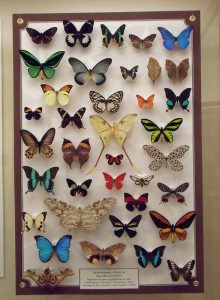What is LifeScanner?
LifeScanner is an app that works with the Barcode of Life Database (BOLD Systems) at the University of Guelph. It includes a database of all the specimens collected all over the planet, as well as kits that allow users to send in their own specimens. I’d like to propose that it has the potential to be used not just to identify species, but as a tool to address essential questions related to biology and inter-curricular inquiries.

Photo by Mike Beauregard on Flickr (under CC BY 2.0).
How can it be used for education?
The app itself can be used to identify species, look up animals that live in your area, and learn about the biodiversity in your backyard, region, or country. With the collection kits, a class could collect and send in specimens to BOLD for DNA barcoding. By exploring the app, students learn more about some of the applications of DNA sequencing and what it can be used to do, like identify food fraud, discover new species, and track the effects of climate change on animal distributions. A class field trip to a park or beach could include using the app to make and check off a list of commonly found animals, helping the students improve their powers of observation. Or, conversely, students could photograph as many animals as they can find, then check with the app to see which ones they did not find, and hypothesize why they were not found. ELL or second-language students could pick an animal, research it, and give a presentation of what they found, expanding their vocabulary.
Using the kits, students are engaged in exploration to find a specimen, develop photography skills to get a set of diagnostic photos, practice hypothesis development when trying to identify the animal as best they can, and participate in real-life citizen science by contributing their specimens to the worldwide BOLD database, which they can see on their app! Students could also be asked to investigate food fraud by collecting samples of meat or seafood that they suspect is not what is labelled (sushi is great for this).
Pros 
- App is free!
- Gets students outside exploring their environment
- Interactive way to learn about genetic technology
- Students can actively contribute to a body of scientific knowledge
- Fun way to learn about the diversity of local species
- Teaches practical skills of observation, photography, search terms in databases
- Students learn about proper food labelling, and the prevalence of food fraud
Cons 
- Currently only available on Apple devices (iPhone, iPad, etc.)
- Collection kits are expensive ($50 for 4 collection kits)
- Animal specimens need to be small enough to fit in the tube or a piece has to be cut off, so the database comprises mostly invertebrate species (i.e. great for bugs or tidepooling, but not birding)
- To collect whole animals, they do have to be sacrificed. This is a moral dilemma that should be discussed as a class, and students should not be required to collect specimens.
Curricular Areas
LifeScanner applications could be used for Science 9/10 (exploring local biodiversity), Life Sciences 11 (DN sequencing, biodiversity, and taxonomy), social studies (food labelling), art (photography, biodiversity), and ELL/second languages (learning French/Spanish words for animals, practicing communication), and math (point sampling, survey methods).

Leave a Reply